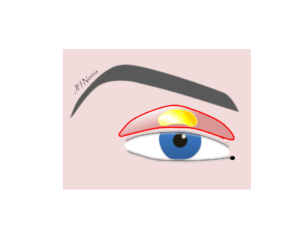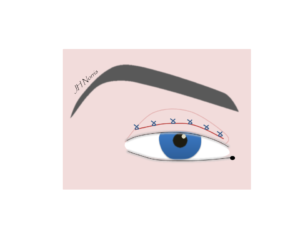
Historically eyelid weights have been made of gold. It is usually in one piece and is less dense that platinum as so requires more volume (i.e. gold weights are normally larger to achieve the same eyelid closure). Allergies to gold have been reported although this is quite rare.
Platinum chains tend to be thinner and less bulky as they have a higher density. The platinum chain also conforms to the shape of the eyelid, which can make it less prominent, particularly using heavier weights. Both gold and platinum are used routinely.


The surgery normally takes about 25 minutes but can sometimes take longer. This type of surgery is usually performed as a day case operation and we normally allow you to go home about 30 minutes after you surgery is finished.
From the eyelid perspective a weight may cause the eyelid to sit too low (a ptosis) or not give the degree of closure necessary. The weights may flatten the contour of the eyelid. Most of these changes in position can be adjusted with a second operation. The most serious risk of any eyelid surgery performed is damage to your eyesight. Fortunately this risk is extremely rare.
We advise that you use an antiobiotic ointment after the surgery (see below) to help reduce the risk of infection.
We advise that you apply ice compresses to the eyelids after surgery for three times a day for 5 minutes each time. This is to help reduce the bruising.
We normally see you after surgery to check the position of the eyelid.
Usually patients are quite anxious after having surgery near their eyes and most problems do settle with time. Problems that require immediate attention are the onset of new double vision, loss of vision and pain that cannot be controlled with regular painkillers. In particular if the eyelid swells up and you cannot open your eye then this requires an urgent review. Please refer to the emergency contact page (in contacts).
Author: Mr Jonathan Norris FRCOphth

